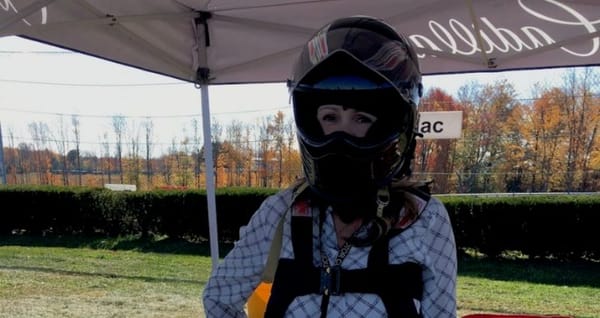Say Buh-Bye, Head Injuries; Hello HANS Device

Racing and HANS are paving the way to concussion-free sports
If you’re the mom, wife, sister or aunt of a helmet-wearing athlete, you worry constantly about concussions (you probably worry if you’re a dad, brother or uncle, too). Concussions are on the rise and now there’s evidence that they not only cause short-term damage, but concussions can have life-long effects and repeated concussions can cause mental illness.
But football is a national pastime. Team sports teach kids to be more successful in life. And, many sports lead to college scholarships. So how do we balance the risk of injury with the benefits of sports that require helmets?
Ask the auto racing industry.
For professional drivers, head protection doesn’t prevent concussions, it prevents death, and helmets have long been required equipment. But still, drivers were suffering devastating injuries. Helmets needed to be more effective.

Enter the HANS or HNR device
Developed more than 20 years ago and instituted by the National Hot Rod Association and Formula 1 racing, the head and neck support (HANS) or head and neck restraint (HNR) prevents the head from ‘pendulum impacts,’ or whipping back and forth in a crash both from the force of impact and the deployment of the airbag; this bouncing can cause damage at the base of the skull, impacting the spine and brain, often fatally.
How HANS devices work
The head and neck restraint essentially secures the helmet to a back brace limiting forward and rear movement. The brace, which fully covers the upper spine, is made of a strong, solid lightweight material such as carbon fiber, and is secured with a very tight strap around the front of the chest. It’s then clipped to the base of the helmet so the entire unit moves as one. Even if a player or driver is impacted, the entire spine moves as a single unit, rather than the head whipping back and forth while the spine stays stationary, which can happen when drivers are tightly strapped in by a harness or seat belt.
This should be required gear

I had the chance to wear an HNR device when I drove the Cadillac ATS-V on the track at Monticello Motor Club recently (and if you’ve never driven on a track, you should try it). I was excited to try this, but really, it’s something I should get used to: Cadillac began requiring that all drivers throughout the company, as well as any media or guests who drive their vehicles on tracks, must wear an HNR device.
And I’m glad. Cadillac’s new rule will help to push the technology and bring down the price so football players from pro to pee wee leagues will wear them.
Surprising comfort and visibility
Adapting to new safety equipment always comes with objections (remember the complaint that seat belts wrinkled our dresses?). So I wondered what my mobility and visibility would be like with the HNR device on, and also, I wondered if it would be comfortable. It was, and my mobility was not affected. After all, I was strapped into the drivers seat, so already I wasn’t all that mobile.
To put it on, I put on the helmet first, then put on the back brace similar to putting on a vest: I put my arms through the straps and the top of the device rested on my shoulders; straps on the side threaded under my arms to connect across my upper chest. The helmet was then clipped to the top of the brace. I had assistance in putting it on, but can see how drivers and athletes can eventually learn to do this themselves.
Once in the HNR device and strapped into the ATS-V, I had full visibility to look left and right, though I did have to make an effort to look up and down; my vertical peripheral vision wasn’t as wide as normal. But once I made the effort, it was easy; it would just take getting used to (and to drive the ATS-V on the track, totally worthwhile).
Consciously crafted to fit everyone

Remember I said the HANS device straps across your chest? This might be something of a concern to women who are probably shaped a little differently than the typical HANS wearer. But cleverly (or perhaps strategically) the device straps across just under your arms, so it fit me just fine, and if anyone would have a challenge being outfitted for something mostly worn by men, it would be me. But thankfully, it fit perfectly, or I wouldn’t have been allowed to drive the ATS-V on the track, something I didn’t want to miss.
Will football, lacrosse and hockey be next?
We’re starting to see more head and neck protection in professional sports, which have been actively researching the use of HANS or HNR devices but not implementing them as quickly as racing did. As a fan who shudders at the audible clash of helmets on football turf, and now as a driver who’s worn one of these devices, I hope so.
More About:Car Technology
